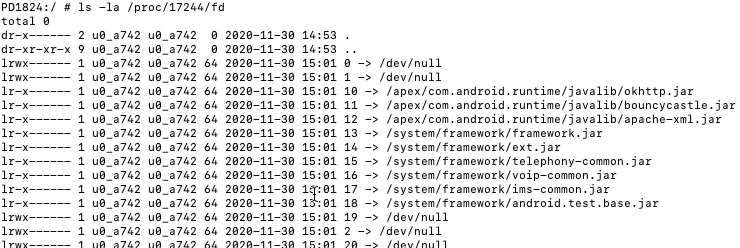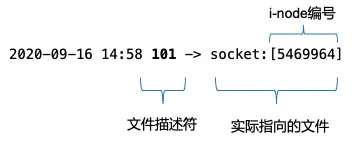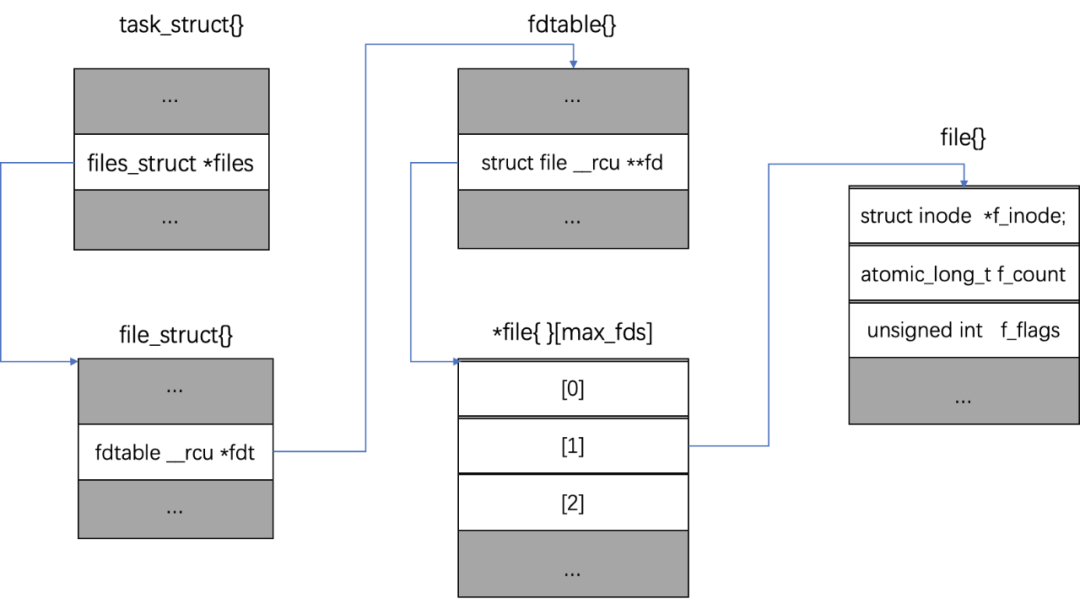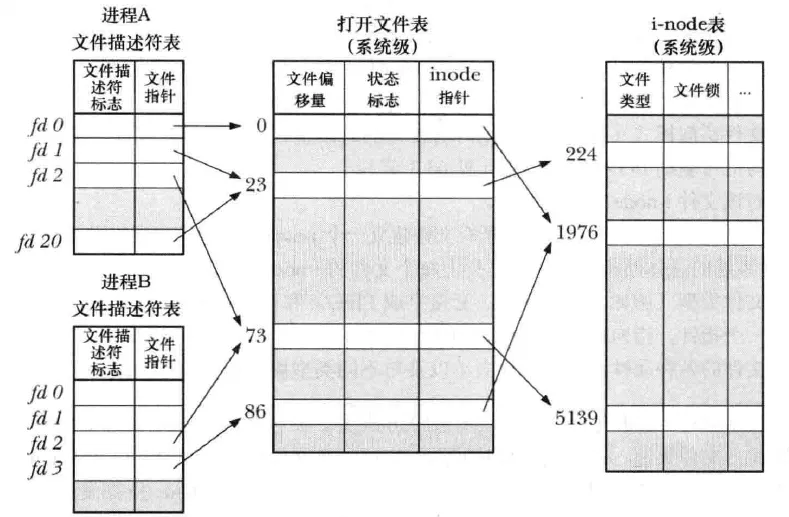一文帮你搞懂 Android 文件描述符
介绍文件描述符的概念以及工作原理,并通过源码了解 Android 中常见的 FD 泄漏。
一、什么是文件描述符?
文件描述符是在 Linux 文件系统的被使用,由于Android基 于Linux 系统,所以Android也继承了文件描述符系统。我们都知道,在 Linux 中一切皆文件,所以系统在运行时有大量的文件操作,内核为了高效管理已被打开的文件会创建索引,用来指向被打开的文件,这个索引即是文件描述符,其表现形式为一个非负整数。
可以通过命令 ls -la /proc/$pid/fd 查看当前进程文件描述符使用信息。

上图中 箭头前的数组部分是文件描述符,箭头指向的部分是对应的文件信息。

Android系统中可以打开的文件描述符是有上限的,所以分到每一个进程可打开的文件描述符也是有限的。可以通过命令 cat /proc/sys/fs/file-max 查看所有进程允许打开的最大文件描述符数量。

当然也可以查看进程的允许打开的最大文件描述符数量。Linux默认进程最大文件描述符数量是1024,但是较新款的Android设置这个值被改为32768。

可以通过命令 ulimit -n 查看,Linux 默认是1024,比较新款的Android设备大部分已经是大于1024的,例如我用的测试机是:32768。
通过概念性的描述,我们知道系统在打开文件的时候会创建文件操作符,后续就通过文件操作符来操作文件。那么,文件描述符在代码上是怎么实现的呢,让我们来看一下Linux中用来描述进程信息的 task_struct 源码。
1 2 3 4 5 6 7 8 9 10 11 12 13 14 15 16 17 | struct task_struct{// 进程状态long state;// 虚拟内存结构体struct mm_struct *mm;// 进程号pid_t pid;// 指向父进程的指针struct task_struct*parent;// 子进程列表struct list_head children;// 存放文件系统信息的指针struct fs_struct* fs;// 存放该进程打开的文件指针数组struct files_struct *files;}; |
task_struct 是 Linux 内核中描述进程信息的对象,其中files指向一个文件指针数组 ,这个数组中保存了这个进程打开的所有文件指针。 每一个进程会用 files_struct 结构体来记录文件描述符的使用情况,这个 files_struct 结构体为用户打开表,它是进程的私有数据,其定义如下:
1 2 3 4 5 6 7 8 9 10 11 12 13 14 15 16 17 18 19 20 21 22 23 | /* * Open file table structure */struct files_struct { /* * read mostly part */ atomic_t count;//自动增量 bool resize_in_progress; wait_queue_head_t resize_wait; struct fdtable __rcu *fdt; //fdtable类型指针 struct fdtable fdtab; //fdtable变量实例 /* * written part on a separate cache line in SMP */ spinlock_t file_lock ____cacheline_aligned_in_smp; unsigned int next_fd; unsigned long close_on_exec_init[1];//执行exec时需要关闭的文件描述符初值结合(从主进程中fork出子进程) unsigned long open_fds_init[1];//todo 含义补充 unsigned long full_fds_bits_init[1];//todo 含义补充 struct file __rcu * fd_array[NR_OPEN_DEFAULT];//默认的文件描述符长度}; |
一般情况,“文件描述符”指的就是文件指针数组 files 的索引。
Linux 在2.6.14版本开始通过引入struct fdtable作为file_struct的间接成员,file_struct中会包含一个struct fdtable的变量实例和一个struct fdtable的类型指针。
1 2 3 4 5 6 7 8 | struct fdtable { unsigned int max_fds; struct file __rcu **fd; //指向文件对象指针数组的指针 unsigned long *close_on_exec; unsigned long *open_fds; //指向打开文件描述符的指针 unsigned long *full_fds_bits; struct rcu_head rcu;}; |
在file_struct初始化创建时,fdt指针指向的其实就是当前的的变量fdtab。当打开文件数超过初始设置的大小时,file_struct发生扩容,扩容后fdt指针会指向新分配的fdtable变量。
1 2 3 4 5 6 7 8 9 10 11 12 13 | struct files_struct init_files = { .count = ATOMIC_INIT(1), .fdt = &init_files.fdtab,//指向当前fdtable .fdtab = { .max_fds = NR_OPEN_DEFAULT, .fd = &init_files.fd_array[0],//指向files_struct中的fd_array .close_on_exec = init_files.close_on_exec_init,//指向files_struct中的close_on_exec_init .open_fds = init_files.open_fds_init,//指向files_struct中的open_fds_init .full_fds_bits = init_files.full_fds_bits_init,//指向files_struct中的full_fds_bits_init }, .file_lock = __SPIN_LOCK_UNLOCKED(init_files.file_lock), .resize_wait = __WAIT_QUEUE_HEAD_INITIALIZER(init_files.resize_wait),}; |
RCU(Read-Copy Update)是数据同步的一种方式,在当前的Linux内核中发挥着重要的作用。
RCU主要针对的数据对象是链表,目的是提高遍历读取数据的效率,为了达到目的使用RCU机制读取数据的时候不对链表进行耗时的加锁操作。这样在同一时间可以有多个线程同时读取该链表,并且允许一个线程对链表进行修改(修改的时候,需要加锁)。
RCU适用于需要频繁的读取数据,而相应修改数据并不多的情景,例如在文件系统中,经常需要查找定位目录,而对目录的修改相对来说并不多,这就是RCU发挥作用的最佳场景。
struct file 处于内核空间,是内核在打开文件时创建,其中保存了文件偏移量,文件的inode等与文件相关的信息,在 Linux 内核中,file结构表示打开的文件描述符,而inode结构表示具体的文件。在文件的所有实例都关闭后,内核释放这个数据结构。
1 2 3 4 5 6 7 8 9 10 11 12 13 14 15 16 17 18 19 20 21 22 23 24 25 26 27 28 29 30 31 32 33 34 35 36 37 38 39 40 | struct file { union { struct llist_node fu_llist; //用于通用文件对象链表的指针 struct rcu_head fu_rcuhead;//RCU(Read-Copy Update)是Linux 2.6内核中新的锁机制 } f_u; struct path f_path;//path结构体,包含vfsmount:指出该文件的已安装的文件系统,dentry:与文件相关的目录项对象 struct inode *f_inode; /* cached value */ const struct file_operations *f_op;//文件操作,当进程打开文件的时候,这个文件的关联inode中的i_fop文件操作会初始化这个f_op字段 /* * Protects f_ep_links, f_flags. * Must not be taken from IRQ context. */ spinlock_t f_lock; enum rw_hint f_write_hint; atomic_long_t f_count; //引用计数 unsigned int f_flags; //打开文件时候指定的标识,对应系统调用open的int flags参数。驱动程序为了支持非阻塞型操作需要检查这个标志 fmode_t f_mode;//对文件的读写模式,对应系统调用open的mod_t mode参数。如果驱动程序需要这个值,可以直接读取这个字段 struct mutex f_pos_lock; loff_t f_pos; //目前文件的相对开头的偏移 struct fown_struct f_owner; const struct cred *f_cred; struct file_ra_state f_ra; u64 f_version;#ifdef CONFIG_SECURITY void *f_security;#endif /* needed for tty driver, and maybe others */ void *private_data; #ifdef CONFIG_EPOLL /* Used by fs/eventpoll.c to link all the hooks to this file */ struct list_head f_ep_links; struct list_head f_tfile_llink;#endif /* #ifdef CONFIG_EPOLL */ struct address_space *f_mapping; errseq_t f_wb_err; errseq_t f_sb_err; /* for syncfs */} |
整体的数据结构示意图如下:

到这里,文件描述符的基本概念已介绍完毕。
二、文件描述符的工作原理
上文介绍了文件描述符的概念和部分源码,如果要进一步理解文件描述符的工作原理,需要查看由内核维护的三个数据结构。
i-node是 Linux 文件系统中重要的概念,系统通过i-node节点读取磁盘数据。表面上,用户通过文件名打开文件。实际上,系统内部先通过文件名找到对应的inode号码,其次通过inode号码获取inode信息,最后根据inode信息,找到文件数据所在的block,读出数据。
三个表的关系如下:

进程的文件描述符表为进程私有,该表的值是从0开始,在进程创建时会把前三位填入默认值,分别指向 标准输入流,标准输出流,标准错误流,系统总是使用最小的可用值。
正常情况一个进程会从fd[0]读取数据,将输出写入fd[1],将错误写入fd[2]
每一个文件描述符都会对应一个打开文件,同时不同的文件描述符也可以对应同一个打开文件。这里的不同文件描述符既可以是同一个进程下,也可以是不同进程。
每一个打开文件也会对应一个i-node条目,同时不同的文件也可以对应同一个i-node条目。
光看对应关系的结论有点乱,需要梳理每种对应关系的场景,帮助我们加深理解。
问题:如果有两个不同的文件描述符且最终对应一个i-node,这种情况下对应一个打开文件和对应多个打开文件有什么区别呢?
答:如果对一个打开文件,则会共享同一个文件偏移量。
举个例子:
fd1和fd2对应同一个打开文件句柄,fd3指向另外一个文件句柄,他们最终都指向一个i-node。
如果fd1先写入“hello”,fd2再写入“world”,那么文件写入为“helloworld”。
fd2会在fd1偏移之后添加写,fd3对应的偏移量为0,所以直接从开始覆盖写。
三、Android中FD泄漏场景
上文介绍了 Linux 系统中文件描述符的含义以及工作原理,下面我们介绍在Android系统中常见的文件描述符泄漏类型。
3.1 HandlerThread泄漏
HandlerThread是Android提供的带消息队列的异步任务处理类,他实际是一个带有Looper的Thread。正常的使用方法如下:
1 2 3 4 5 6 7 8 9 10 11 12 13 14 15 16 17 18 19 20 21 | //初始化private void init(){ //init if(null != mHandlerThread){ mHandlerThread = new HandlerThread("fd-test"); mHandlerThread.start(); mHandler = new Handler(mHandlerThread.getLooper()); }} //释放handlerThreadprivate void release(){ if(null != mHandler){ mHandler.removeCallbacksAndMessages(null); mHandler = null; } if(null != mHandlerThread){ mHandlerThread.quitSafely(); mHandlerThread = null; }} |
HandlerThread在不需要使用的时候,需要调用上述代码中的release方法来释放资源,比如在Activity退出时。另外全局的HandlerThread可能存在被多次赋值的情况,需要做空判断或者先释放再赋值,也需要重点关注。
HandlerThread会泄漏文件描述符的原因是使用了Looper,所以如果普通Thread中使用了Looper,也会有这个问题。下面让我们来分析一下Looper的代码,查看到底是在哪里调用的文件操作。
HandlerThread在run方法中调用Looper.prepare();
1 2 3 4 5 6 7 8 9 10 11 12 | public void run() { mTid = Process.myTid(); Looper.prepare(); synchronized (this) { mLooper = Looper.myLooper(); notifyAll(); } Process.setThreadPriority(mPriority); onLooperPrepared(); Looper.loop(); mTid = -1;} |
Looper在构造方法中创建MessageQueue对象。
1 2 3 4 | private Looper(boolean quitAllowed) { mQueue = new MessageQueue(quitAllowed); mThread = Thread.currentThread();} |
MessageQueue,也就是我们在Handler学习中经常提到的消息队列,在构造方法中调用了native层的初始化方法。
1 2 3 4 | MessageQueue(boolean quitAllowed) { mQuitAllowed = quitAllowed; mPtr = nativeInit();//native层代码} |
MessageQueue对应native代码,这段代码主要是初始化了一个NativeMessageQueue,然后返回一个long型到Java层。
1 2 3 4 5 6 7 8 9 | static jlong android_os_MessageQueue_nativeInit(JNIEnv* env, jclass clazz) { NativeMessageQueue* nativeMessageQueue = new NativeMessageQueue(); if (!nativeMessageQueue) { jniThrowRuntimeException(env, "Unable to allocate native queue"); return 0; } nativeMessageQueue->incStrong(env); return reinterpret_cast<jlong>(nativeMessageQueue);} |
NativeMessageQueue初始化方法中会先判断是否存在当前线程的Native层的Looper,如果没有的就创建一个新的Looper并保存。
1 2 3 4 5 6 7 | NativeMessageQueue::NativeMessageQueue() :mPollEnv(NULL), mPollObj(NULL), mExceptionObj(NULL) { mLooper = Looper::getForThread(); if (mLooper == NULL) { mLooper = new Looper(false); Looper::setForThread(mLooper); }} |
在Looper的构造函数中,我们发现“eventfd”,这个很有文件描述符特征的方法。
1 2 3 4 5 6 7 8 9 10 11 12 | Looper::Looper(bool allowNonCallbacks): mAllowNonCallbacks(allowNonCallbacks), mSendingMessage(false), mPolling(false), mEpollRebuildRequired(false), mNextRequestSeq(0), mResponseIndex(0), mNextMessageUptime(LLONG_MAX) { mWakeEventFd.reset(eventfd(0, EFD_NONBLOCK | EFD_CLOEXEC));//eventfd LOG_ALWAYS_FATAL_IF(mWakeEventFd.get() < 0, "Could not make wake event fd: %s", strerror(errno)); AutoMutex _l(mLock); rebuildEpollLocked();} |
从C++代码注释中可以知道eventfd函数会返回一个新的文件描述符。
1 2 3 4 5 6 7 | /** * [eventfd(2)](http://man7.org/linux/man-pages/man2/eventfd.2.html) creates a file descriptor * for event notification. * * Returns a new file descriptor on success, and returns -1 and sets `errno` on failure. */int eventfd(unsigned int __initial_value, int __flags); |
3.2 IO泄漏
IO操作是Android开发过程中常用的操作,如果没有正确关闭流操作,除了可能会导致内存泄漏,也会导致FD的泄漏。常见的问题代码如下:
1 2 3 4 5 6 7 8 9 10 11 | private void ioTest(){ try { File file = new File(getCacheDir(), "testFdFile"); file.createNewFile(); FileOutputStream out = new FileOutputStream(file); //do something out.close(); }catch (Exception e){ e.printStackTrace(); }} |
如果在流操作过程中发生异常,就有可能导致泄漏。正确的写法应该是在final块中关闭流。
1 2 3 4 5 6 7 8 9 10 11 12 13 14 15 16 17 18 19 20 | private void ioTest() { FileOutputStream out = null; try { File file = new File(getCacheDir(), "testFdFile"); file.createNewFile(); out = new FileOutputStream(file); //do something out.close(); } catch (Exception e) { e.printStackTrace(); } finally { if (null != out) { try { out.close(); } catch (IOException e) { e.printStackTrace(); } } }} |
同样,我们在从源码中寻找流操作是如何创建文件描述符的。首先,查看 FileOutputStream 的构造方法 ,可以发现会初始化一个名为fd的 FileDescriptor 变量,这个 FileDescriptor 对象是Java层对native文件描述符的封装,其中只包含一个int类型的成员变量,这个变量的值就是native层创建的文件描述符的值。
1 2 3 4 5 6 7 8 | public FileOutputStream(File file, boolean append) throws FileNotFoundException{ //...... this.fd = new FileDescriptor(); //...... open(name, append); //......} |
open方法会直接调用jni方法open0.
1 2 3 4 5 6 7 8 9 10 11 12 | /** * Opens a file, with the specified name, for overwriting or appending. * @param name name of file to be opened * @param append whether the file is to be opened in append mode */private native void open0(String name, boolean append) throws FileNotFoundException; private void open(String name, boolean append) throws FileNotFoundException { open0(name, append);} |
Tips: 我们在看android源码时常常遇到native方法,通过Android Studio无法跳转查看,可以在 androidxref 网站,通过“Java类名_native方法名”的方法进行搜索。例如,这可以搜索 FileOutputStream_open0 。
接下来,让我们进入native方法查看对应实现。
1 2 3 4 5 | JNIEXPORT void JNICALLFileOutputStream_open0(JNIEnv *env, jobject this, jstring path, jboolean append) { fileOpen(env, this, path, fos_fd, O_WRONLY | O_CREAT | (append ? O_APPEND : O_TRUNC));} |
在fileOpen方法中,通过handleOpen生成native层的文件描述符(fd),这个fd就是这个所谓对面的文件描述符。
1 2 3 4 5 6 7 8 9 10 11 12 13 14 15 16 17 18 19 20 21 22 23 24 25 26 27 28 29 | void fileOpen(JNIEnv *env, jobject this, jstring path, jfieldID fid, int flags){ WITH_PLATFORM_STRING(env, path, ps) { FD fd; //...... fd = handleOpen(ps, flags, 0666); if (fd != -1) { SET_FD(this, fd, fid); } else { throwFileNotFoundException(env, path); } } END_PLATFORM_STRING(env, ps);} FD handleOpen(const char *path, int oflag, int mode) { FD fd; RESTARTABLE(open64(path, oflag, mode), fd);//调用open,获取fd if (fd != -1) { //...... if (result != -1) { //...... } else { close(fd); fd = -1; } } return fd;} |
到这里就结束了吗?
回到开始,FileOutputStream构造方法中初始化了Java层的文件描述符类 FileDescriptor,目前这个对象中的文件描述符的值还是初始的-1,所以目前它还是一个无效的文件描述符,native层完成fd创建后,还需要把fd的值传到 Java层。
我们再来看SET_FD这个宏的定义,在这个宏定义中,通过反射的方式给Java层对象的成员变量赋值。由于上文内容可知,open0是对象的jni方法,所以宏中的this,就是初始创建的FileOutputStream在Java层的对象实例。
1 2 3 | #define SET_FD(this, fd, fid) \ if ((*env)->GetObjectField(env, (this), (fid)) != NULL) \ (*env)->SetIntField(env, (*env)->GetObjectField(env, (this), (fid)),IO_fd_fdID, (fd)) |
而fid则会在native代码中提前初始化好。
1 2 3 4 | static void FileOutputStream_initIDs(JNIEnv *env) { jclass clazz = (*env)->FindClass(env, "java/io/FileOutputStream"); fos_fd = (*env)->GetFieldID(env, clazz, "fd", "Ljava/io/FileDescriptor;");} |
收,到这里FileOutputStream的初始化跟进就完成了,我们已经找到了底层fd初始化的路径。Android的IO操作还有其他的流操作类,大致流程基本类似,这里不再细述。
并不是不关闭就一定会导致文件描述符泄漏,在流对象的析构方法中会调用close方法,所以这个对象被回收时,理论上也是会释放文件描述符。但是最好还是通过代码控制释放逻辑。
3.3 SQLite泄漏
在日常开发中如果使用数据库SQLite管理本地数据,在数据库查询的cursor使用完成后,亦需要调用close方法释放资源,否则也有可能导致内存和文件描述符的泄漏。
1 2 3 4 5 6 7 8 9 10 11 12 13 | public void get() { db = ordersDBHelper.getReadableDatabase(); Cursor cursor = db.query(...); while (cursor.moveToNext()) { //...... } if(flag){ //某种原因导致retrn return; } //不调用close,fd就会泄漏 cursor.close();} |
按照理解query操作应该会导致文件描述符泄漏,那我们就从query方法的实现开始分析。
然而,在query方法中并没有发现文件描述符相关的代码。
经过测试发现,moveToNext 调用后才会导致文件描述符增长。通过query方法可以获取cursor的实现类SQLiteCursor。
1 2 3 4 5 6 7 8 9 10 11 | public Cursor query(CursorFactory factory, String[] selectionArgs) { final SQLiteQuery query = new SQLiteQuery(mDatabase, mSql, mCancellationSignal); final Cursor cursor; //...... if (factory == null) { cursor = new SQLiteCursor(this, mEditTable, query); } else { cursor = factory.newCursor(mDatabase, this, mEditTable, query); } //......} |
在SQLiteCursor的父类找到moveToNext的实现。getCount 是抽象方法,在子类SQLiteCursor实现。
1 2 3 4 5 6 7 8 9 10 11 12 13 | @Overridepublic final boolean moveToNext() { return moveToPosition(mPos + 1);}public final boolean moveToPosition(int position) { // Make sure position isn't past the end of the cursor final int count = getCount(); if (position >= count) { mPos = count; return false; } //......} |
getCount 方法中对成员变量mCount做判断,如果还是初始值,则会调用fillWindow方法。
1 2 3 4 5 6 7 8 9 10 11 | @Overridepublic int getCount() { if (mCount == NO_COUNT) { fillWindow(0); } return mCount;}private void fillWindow(int requiredPos) { clearOrCreateWindow(getDatabase().getPath()); //......} |
clearOrCreateWindow 实现又回到父类 AbstractWindowedCursor 中。
1 2 3 4 5 6 7 | protected void clearOrCreateWindow(String name) { if (mWindow == null) { mWindow = new CursorWindow(name); } else { mWindow.clear(); }} |
在CursorWindow的构造方法中,通过nativeCreate方法调用到native层的初始化。
1 2 3 4 5 | public CursorWindow(String name, @BytesLong long windowSizeBytes) { //...... mWindowPtr = nativeCreate(mName, (int) windowSizeBytes); //......} |
在C++代码中会继续调用一个native层CursorWindow的create方法。
1 2 3 4 5 6 7 | static jlong nativeCreate(JNIEnv* env, jclass clazz, jstring nameObj, jint cursorWindowSize) { //...... CursorWindow* window; status_t status = CursorWindow::create(name, cursorWindowSize, &window); //...... return reinterpret_cast<jlong>(window);} |
在CursorWindow的create方法中,我们可以发现fd创建相关的代码。
1 2 3 4 5 6 7 | status_t CursorWindow::create(const String8& name, size_t size, CursorWindow** outCursorWindow) { String8 ashmemName("CursorWindow: "); ashmemName.append(name); status_t result; int ashmemFd = ashmem_create_region(ashmemName.string(), size); //......} |
ashmem_create_region 方法最终会调用到open函数打开文件并返回系统创建的文件描述符。这部分代码不在赘述,有兴趣的可以自行查看 。
native完成初始化会把fd信息保存在CursorWindow中并会返回一个指针地址到Java层,Java层可以通过这个指针操作c++层对象从而也能获取对应的文件描述符。
3.4 InputChannel 导致的泄漏
WindowManager.addView
通过WindowManager反复添加view也会导致文件描述符增长,可以通过调用removeView释放之前创建的FD。
1 2 3 4 5 | private void addView() { View windowView = LayoutInflater.from(getApplication()).inflate(R.layout.layout_window, null); //重复调用 mWindowManager.addView(windowView, wmParams);} |
WindowManagerImpl中的addView最终会走到ViewRootImpl的setView。
1 2 3 4 5 6 | public void addView(View view, ViewGroup.LayoutParams params, Display display, Window parentWindow) { //...... root = new ViewRootImpl(view.getContext(), display); //...... root.setView(view, wparams, panelParentView);} |
setView中会创建InputChannel,并通过Binder机制传到服务端。
1 2 3 4 5 6 7 8 9 10 11 12 13 14 15 16 17 18 19 20 21 22 23 | public void setView(View view, WindowManager.LayoutParams attrs, View panelParentView) { //...... //创建inputchannel if ((mWindowAttributes.inputFeatures & WindowManager.LayoutParams.INPUT_FEATURE_NO_INPUT_CHANNEL) == 0) { mInputChannel = new InputChannel(); } //远程服务接口 res = mWindowSession.addToDisplay(mWindow, mSeq, mWindowAttributes, getHostVisibility(), mDisplay.getDisplayId(), mWinFrame, mAttachInfo.mContentInsets, mAttachInfo.mStableInsets, mAttachInfo.mOutsets, mAttachInfo.mDisplayCutout, mInputChannel);//mInputChannel 作为参数传过去 //...... if (mInputChannel != null) { if (mInputQueueCallback != null) { mInputQueue = new InputQueue(); mInputQueueCallback.onInputQueueCreated(mInputQueue); } //创建 WindowInputEventReceiver 对象 mInputEventReceiver = new WindowInputEventReceiver(mInputChannel, Looper.myLooper()); }} |
addToDisplay是一个AIDL方法,它的实现类是源码中的Session。最终调用的是 WindowManagerService 的 addWIndow 方法。
1 2 3 4 5 6 7 8 9 | public int addToDisplay(IWindow window, int seq, WindowManager.LayoutParams attrs, int viewVisibility, int displayId, Rect outFrame, Rect outContentInsets, Rect outStableInsets, DisplayCutout.ParcelableWrapper outDisplayCutout, InputChannel outInputChannel, InsetsState outInsetsState, InsetsSourceControl[] outActiveControls) { return mService.addWindow(this, window, seq, attrs, viewVisibility, displayId, outFrame, outContentInsets, outStableInsets, outDisplayCutout, outInputChannel, outInsetsState, outActiveControls, UserHandle.getUserId(mUid));} |
WMS在 addWindow 方法中创建 InputChannel 用于通讯。
1 2 3 4 5 6 7 8 9 10 11 12 | public int addWindow(Session session, IWindow client, int seq, LayoutParams attrs, int viewVisibility, int displayId, Rect outFrame, Rect outContentInsets, Rect outStableInsets, Rect outOutsets, DisplayCutout.ParcelableWrapper outDisplayCutout, InputChannel outInputChannel) { //...... final boolean openInputChannels = (outInputChannel != null && (attrs.inputFeatures & INPUT_FEATURE_NO_INPUT_CHANNEL) == 0); if (openInputChannels) { win.openInputChannel(outInputChannel); } //......} |
在 openInputChannel 中创建 InputChannel ,并把客户端的传回去。
1 2 3 4 5 6 7 | void openInputChannel(InputChannel outInputChannel) { //...... InputChannel[] inputChannels = InputChannel.openInputChannelPair(name); mInputChannel = inputChannels[0]; mClientChannel = inputChannels[1]; //......} |
InputChannel 的 openInputChannelPair 会调用native的 nativeOpenInputChannelPair ,在native中创建两个带有文件描述符的 socket 。
1 2 3 4 5 6 7 8 9 10 | int socketpair(int domain, int type, int protocol, int sv[2]) { //创建一对匿名的已经连接的套接字 int rc = __socketpair(domain, type, protocol, sv); if (rc == 0) { //跟踪文件描述符 FDTRACK_CREATE(sv[0]); FDTRACK_CREATE(sv[1]); } return rc;} |
WindowManager 的分析涉及WMS,WMS内容比较多,本文重点关注文件描述符相关的内容。简单的理解,就是进程间通讯会创建socket,所以也会创建文件描述符,而且会在服务端进程和客户端进程各创建一个。另外,如果系统进程文件描述符过多,理论上会造成系统崩溃。
四、如何排查
如果你的应用收到如下这些崩溃堆栈,恭喜你,你的应用存在文件描述符泄漏。
- abort message 'could not create instance too many files'
- could not read input file descriptors from parcel
- socket failed:EMFILE (Too many open files)
- ...
文件描述符导致的崩溃往往无法通过堆栈直接分析。道理很简单: 出问题的代码在消耗文件描述符同时,正常的代码逻辑可能也同样在创建文件描述符,所以崩溃可能是被正常代码触发了。
4.1 打印当前FD信息
遇到这类问题可以先尝试本体复现,通过命令 ‘ls -la /proc/$pid/fd’ 查看当前进程文件描述符的消耗情况。一般android应用的文件描述符可以分为几类,通过对比哪一类文件描述符数量过高,来缩小问题范围。
4.2 dump系统信息
通过dumpsys window ,查看是否有异常window。用于解决 InputChannel 相关的泄漏问题。
4.3 线上监控
如果是本地无法复现问题,可以尝试添加线上监控代码,定时轮询当前进程使用的FD数量,在达到阈值时,读取当前FD的信息,并传到后台分析,获取FD对应文件信息的代码如下。
1 2 3 4 5 | if (Build.VERSION.SDK_INT >= VersionCodes.L) { linkTarget = Os.readlink(file.getAbsolutePath());} else { //通过 readlink 读取文件描述符信息} |
4.4 排查循环打印的日志
除了直接对 FD相关的信息进行分析,还需要关注logcat中是否有频繁打印的信息,例如:socket创建失败。




【推荐】编程新体验,更懂你的AI,立即体验豆包MarsCode编程助手
【推荐】凌霞软件回馈社区,博客园 & 1Panel & Halo 联合会员上线
【推荐】抖音旗下AI助手豆包,你的智能百科全书,全免费不限次数
【推荐】博客园社区专享云产品让利特惠,阿里云新客6.5折上折
【推荐】轻量又高性能的 SSH 工具 IShell:AI 加持,快人一步
· 一个奇形怪状的面试题:Bean中的CHM要不要加volatile?
· [.NET]调用本地 Deepseek 模型
· 一个费力不讨好的项目,让我损失了近一半的绩效!
· .NET Core 托管堆内存泄露/CPU异常的常见思路
· PostgreSQL 和 SQL Server 在统计信息维护中的关键差异
· DeepSeek “源神”启动!「GitHub 热点速览」
· 我与微信审核的“相爱相杀”看个人小程序副业
· 上周热点回顾(2.17-2.23)
· 如何使用 Uni-app 实现视频聊天(源码,支持安卓、iOS)
· C# 集成 DeepSeek 模型实现 AI 私有化(本地部署与 API 调用教程)